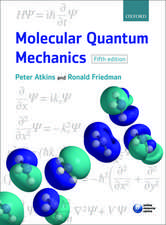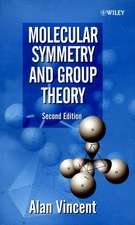An Ordering Concept on the Basis of Alternative Principles in Chemistry: Design of Chemicals and Chemical Reactions by Differentiation and Compensation: Reactivity and Structure: Concepts in Organic Chemistry, cartea 28
R. Boese Autor Paul Heimbach R. Budnik Autor Tamas Bartik H. Hey, A.I. Heimbach, W. Knott, H.G. Preis, H. Schenkluhn, G. Szcendzina, K. Tani, E. Zeppenfelden Limba Engleză Paperback – 8 dec 2011
Din seria Reactivity and Structure: Concepts in Organic Chemistry
- 15%
 Preț: 637.93 lei
Preț: 637.93 lei - 15%
 Preț: 638.57 lei
Preț: 638.57 lei -
 Preț: 402.76 lei
Preț: 402.76 lei -
 Preț: 388.13 lei
Preț: 388.13 lei - 15%
 Preț: 650.19 lei
Preț: 650.19 lei -
 Preț: 400.65 lei
Preț: 400.65 lei - 18%
 Preț: 721.63 lei
Preț: 721.63 lei -
 Preț: 378.71 lei
Preț: 378.71 lei -
 Preț: 378.71 lei
Preț: 378.71 lei - 15%
 Preț: 641.53 lei
Preț: 641.53 lei -
 Preț: 380.84 lei
Preț: 380.84 lei - 15%
 Preț: 636.45 lei
Preț: 636.45 lei - 15%
 Preț: 650.37 lei
Preț: 650.37 lei - 15%
 Preț: 640.08 lei
Preț: 640.08 lei -
 Preț: 387.75 lei
Preț: 387.75 lei - 15%
 Preț: 640.06 lei
Preț: 640.06 lei -
 Preț: 387.20 lei
Preț: 387.20 lei -
 Preț: 380.84 lei
Preț: 380.84 lei - 15%
 Preț: 639.08 lei
Preț: 639.08 lei -
 Preț: 381.81 lei
Preț: 381.81 lei -
 Preț: 382.57 lei
Preț: 382.57 lei -
 Preț: 395.25 lei
Preț: 395.25 lei - 15%
 Preț: 642.83 lei
Preț: 642.83 lei - 15%
 Preț: 643.34 lei
Preț: 643.34 lei -
 Preț: 378.54 lei
Preț: 378.54 lei - 15%
 Preț: 636.45 lei
Preț: 636.45 lei - 20%
 Preț: 546.18 lei
Preț: 546.18 lei - 15%
 Preț: 638.43 lei
Preț: 638.43 lei
Preț: 639.08 lei
Preț vechi: 751.86 lei
-15% Nou
Puncte Express: 959
Preț estimativ în valută:
122.29€ • 130.77$ • 101.96£
122.29€ • 130.77$ • 101.96£
Carte tipărită la comandă
Livrare economică 18 aprilie-02 mai
Preluare comenzi: 021 569.72.76
Specificații
ISBN-13: 9783642838088
ISBN-10: 3642838081
Pagini: 236
Ilustrații: XVII, 214 p.
Dimensiuni: 170 x 242 x 12 mm
Greutate: 0.38 kg
Ediția:Softcover reprint of the original 1st ed. 1990
Editura: Springer Berlin, Heidelberg
Colecția Springer
Seria Reactivity and Structure: Concepts in Organic Chemistry
Locul publicării:Berlin, Heidelberg, Germany
ISBN-10: 3642838081
Pagini: 236
Ilustrații: XVII, 214 p.
Dimensiuni: 170 x 242 x 12 mm
Greutate: 0.38 kg
Ediția:Softcover reprint of the original 1st ed. 1990
Editura: Springer Berlin, Heidelberg
Colecția Springer
Seria Reactivity and Structure: Concepts in Organic Chemistry
Locul publicării:Berlin, Heidelberg, Germany
Public țintă
ResearchCuprins
1 Introduction.- 2 Characterization of Substituents by Patterns and Recognition of ALTERNATIVE PRINCIPLES.- 2.1 Correlation with the Parameter Sets ? and ? by Tolman.- 2.2 Systematic Variations at Tetrahedral Centers: A New Parameter Set ?.- 2.3 The Importance of the Representative Substituents -OMe/-SMe and -CMe3/-SiMe3.- 2.4 The Importance of P- and ?-parameter Sets for Pattern Comparison.- 2.5 The Importance of Compensation Phenomena.- 2.6 Further Characterization of Substituents by Pattern Comparison.- 2.7 Conformational Changes in Phenyl Systems.- 3 Examples of Absolute, Alternative Orders in Chemical Systems by Pairs and Alternating Classes of ALTERNATIVE PRINCIPLES.- 3.1 Examples for the Absolute, Alternative Effects by ACC/DO Heteroatoms.- 3.2 Separation of Main Group and Transition Metal Elements in Four Sectors (PSE-sectors).- 3.3 Errors of Logical Typing in DO/ACC Alternatives.- 3.4 The Alternative Principles EVEN/ODD.- 3.5 Aspects of Coupling Chemical Subsystems: The Alternative Principles OPEN/CYCLIC.- 3.6 The Metala-Logy Principle.- 3.7 The Principle of Alternative Positions.- 3.8 The Alternative Principles IONIC/COVALENT.- 4 Representation of Differentiation and Compensation of ALTERNATIVE PRINCIPLES.- 4.1 On the Definition of Paritetic and Complementary ALTERNATIVE PRINCIPLES and their Effects.- 4.2 Differentiation and Compensation of Two Pairs of AL lERNATIVE PRINCIPLES.- 4.3 Alternative Patterns by Classes of ALTERNATIVE PRINCIPLES.- 4.4 Symmetric/ Antisymmetric Coupling of Two Pairs of ALTERNATIVE PRINCIPLES.- 4.5 Representation in Hierarchically Ordered, Multi-dual Decision-trees.- 5 Representative Examples of Multi-dual Decision — Trees: A Generalization of Phase Relation Rules.- 5.1 The Control of Elimination Reactions by ALTERNATIVEPRINCIPLES.- 5.2 The Alternative Control of Knoevenagel Versus Michael Reaction of Mesityloxide.- 5.3 Control of Asymmetric Synthesis in a Metal-induced Ketone Synthesis.- 5.4 Influence on Structures and Processes in Transition Metal Complexes.- 5.5 A Comparison of the Catalytic Oligomerizations of Propanal.- 6 The Discontinuous Method of INVERSE TITRATION.- 6.1 Evidence in Support of Concentration Effects: A Summary.- 6.2 Examples for the Application of INVERSE TITRATION.- 6.3 Outlook and Unsettled Problems.- 7 Molecular Architecture: Some Definitions.- 7.1 Structure of the Whole System.- 7.2 Intermolecular SYSTEM ENLARGEMENT.- 7.3 Intramolecular SYSTEM ENLARGEMENT and VARIATION: Substitution of Hydrogen by Substituents and Carbon by Heteroatoms.- 7.4 Coupling of Subsystems.- 7.5 Symmetry Aspects in the Coupling of Chemical Subsystems.- 8 Models and Methods for the Understanding of Self-organization and Synergetics in Chemical Systems.- 8.1 The Ordering CONCEPT OF ALTERNATIVE PRINCIPLES in a Comprehensive Form.- 8.2 Some Statements to the Application of the CONCEPT OF ALTERNATIVE PRINCIPLES.- 8.3 Application of the CONCEPT OF ALTERNATIVE PRINCIPLES as Compensation Strategy.- 9 Information from Alternatives in Biochemistry.- 9.1 Alternative Information on Nucleic Acids and ?-Amino-Carboxylic Acids.- 9.2 Alternative Information at Bio-membranes.- 9.3 Chirality, an Error in Logical Typing.- 9.4 Restriction of the Number of Realizations in Evolved Systems.- 10 Acknowledgements and Petition.- 11 Appendix.- 12 References.- 13 Epilogue.












